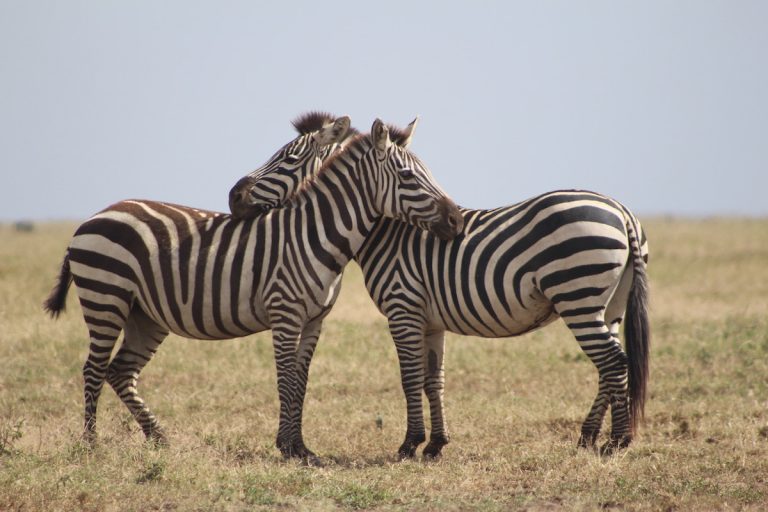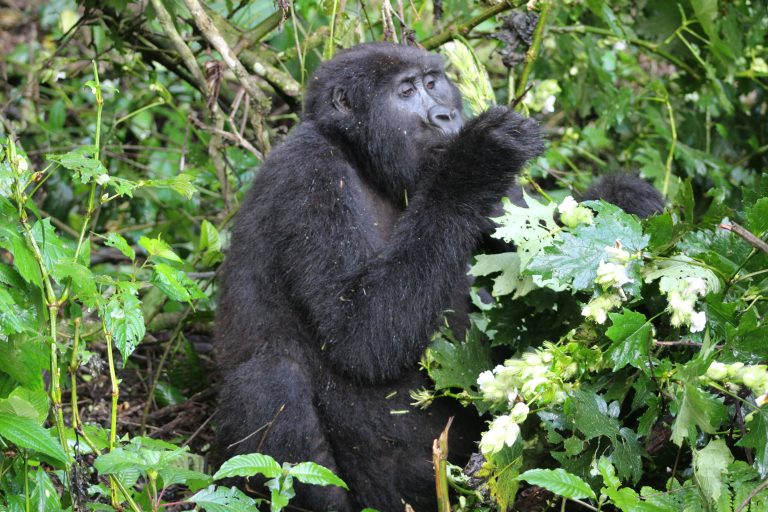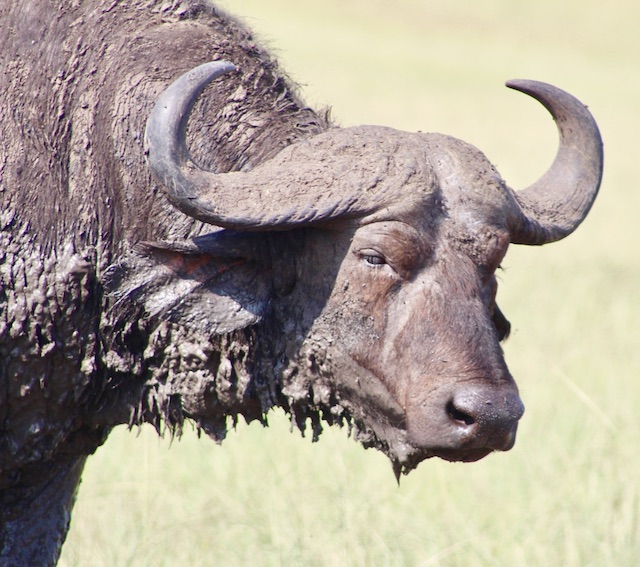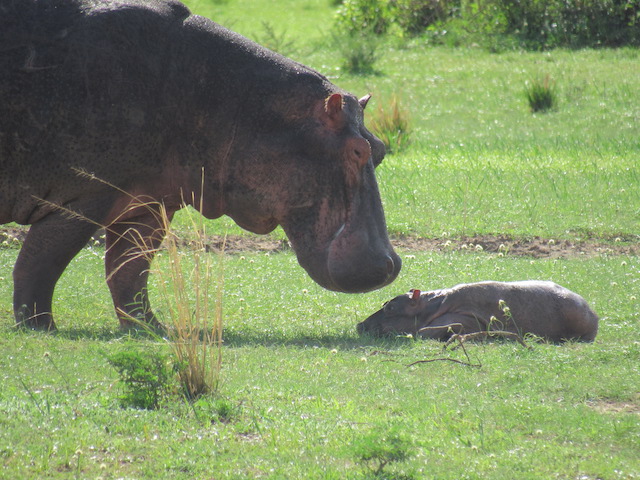Masai Mara National Reserve
Located in southwest Kenya, Masai Mara National Reserve is Kenya’s biggest highlight for anyone traveling to Kenya for safari. It is generally known simply as The Mara, Maasai Mara is in Narok, Kenya, bordering Tanzania’s Serengeti National Park. The reserve is named after the Maasai tribe, the area’s original occupants who originated from the Nile Basin. The term “Mara” means “spotted” in the indigenous Maasai language which means spotted from a distance. The Mara is one of Africa’s most recognized and significant wildlife conservation areas, famous for its remarkable concentrations of the African big five, big cats, and a variety of angulates. The national reserve further hosts the Great Annual Wildebeest, which has earned it a reputation as one of Africa’s Seven Natural Wonders.
Masai Mara National Reserve encompasses 1,510 square kilometers and rises 1,500-2,170 meters above sea level and has been a wildlife reserve for over 50 years. The national reserve was founded in 1961 as a wildlife sanctuary with a total land area of only 520 square kilometers at the time and it included the Mara Triangle). By 1974, the sanctuary had increased in size and it was designated as a National Reserve, covering an area of approximately 1,872 square kilometers. However, a portion of the land has been given to the Maasai local populations, and the Mara ecosystem now covers 1,510 square kilometers. The Maasai have long depended on their land to raise their cattle and feed their families and have been able to maintain their way of life due to the formation of the reserve as a protected area for the conservation of the wilderness, as well as the designation of regions as conservancies. The Mara’s northern portion extends into Tanzania’s Serengeti National Park and together, these form the Mara-Serengeti eco-system which constitutes one of Africa’s most diversified and spectacular ecosystems.
Masai Mara boasts a remarkable landscape made up of rolling hills, sprawling savannah, riverine woodland, and short bushy trees that dot the landscape. The national reserve also has three rivers namely; the Sand River, the Talek River, and the Mara River. The park is separated into two sections: the inner portion, which features pure wilderness, and the outside portion, which has conservancies and permits Masai cattle grazing.
Masai Mara Conservancies
The Greater Masai Mara conservation area includes the Masai Mara National Reserve, an unfenced reserve where wild animals can roam freely, as well as several conservancies. These conservancies are privately owned by Maasai families. These conservancies were designated to allocate the Maasai enough land to graze their cattle and Maasai farmers can be seen cultivating and grazing their cattle on occasion at the conservancies. Most safari lodges and camps lease property from Maasai families, allowing them to engage in their communities by sponsoring education or development activities. The establishment of these conservancies has resulted in a win-win situation for both the reserve and the Maasai as land that was once overgrazed by livestock is now being rewilded. Additionally, the Maasai can invest in their communities thanks to the conservancies’ earnings from tourism. Conservancies in the Masai Mara Conservation Area include Lemek, Siana, Ol Chorro Oirowua, Koiyaki, Olkinyei, Oloirien, Naikara, Ol Derkesi, Maji Moto, Kerinkani, and Kimintet.
Attractions in Masai Mara National Reserve
Wildlife
Masai Mara National Reserve is famous for the diversity of wild animals including numerous predator species. The park is home to over 95 animal species and more than 500 recorded bird species. The Mara is one of Africa’s most popular safari destinations. It is well-known for hosting the big five i.e. Elephants, Rhinos, Buffaloes, Leopards and Lions, and it is home to the native black rhino population. In addition to the big five, the reserve is home to grazers such as impalas, duikers, hartebeests, roan antelopes, zebras, giraffes, topi, wildebeest, and Thomson’s gazelles. Because of the large wildebeest migration from the Serengeti and Loita Plains, the overall population of several of these angulates varies depending on the season. Other wildlife species in the Mara include Crocodiles, Hippopotamus, jackals, cheetahs, hyenas, servals, and foxes, among others.
The Great Wildebeest Migration
The Great Wildebeest Migration is Mara’s top safari attraction. Every year, from July to October, the Masai Mara serves as the setting for one of the most amazing animal displays on the planet – the Great Migration. The tanned grasses of the undulating savannah host more than 1.5 million zebra, wildebeest, and antelopes migrating from the Serengeti in Tanzania to the Mara in search of richer pastures and water. The Great Wildebeest Migration occurs in the Serengeti and Masai Mara and no wildlife spectacle in the world beats it. Sightings of the migration are not often guaranteed, but if you want to catch the experience, please keep the following tracks of their movements;
The never-ending stream of migrating prey attracts the big cats with a limitless range of feeding alternatives. During this time of year, it is easy to sight predators such as lions, leopards, and cheetahs hunting healthy young prey for food. However, the Mara has few lion prides and the female lions are permanent members of the pride, while the males are often banished by other male lions.
Around mid-July, the herds arrive in the Masai Mara and begin their perilous Mara River crossing. Here, crocodiles and hippos on the Mara River’s banks are two of the threats that wildebeest and zebra face when crossing the river.
Between September to October, the wildebeest are temporarily feasting on the lush savannah grassland of the Mara and this is the time of the year when travelers get to observe the incredible animals.
Birdlife in Masai Mara
With over 500 recorded bird species to see including 47 birds of prey, Masai Mara is a bird haven for birding enthusiasts. Bird species in Masai Mara range from the world’s largest bird – the ostrich, to microscopic small sunbirds. Savannah species in the park include Ground Hornbills, Kori Bustards, Secretary Birds, Jaunty Crowned-Plovers, and flocks of White Storks, among many others.
The Park’s riverine habitats, on the other hand, are home to spectacular flocks of Grey-Crowned Cranes, Sacred Ibis, Goliath Heron, Black-headed Heron, Saddle-Billed Storks, Yellow-Billed Storks, Grey Heron, and Great White Egret, to mention but a few. The Mara river is home to several kingfisher species whereas the river’s forest hosts species such as the Ross’s Turaco and Schalow’s Turaco. The best birding spot in Masai Mara is the Musiara Marsh which is the only area in Kenya where the Rufous-bellied Heron nests. Also, the Madagascar Squacco Heron is endemic to this area. Birds of prey in Masai Mara National reserve include the Martial eagle, Bateleur, and Pygmy Falcon.
Activities in Masai Mara National Reserve
Game Drives/Game viewing
With an incredible diversity of wildlife and spectacular landscape, game drives in Masai Mara are very rewarding. Adventured in a 4×4 open roof safari vehicle, game drives Masai Mara will offer you close clear views of wild animals while adhering to the restrictions. Game drives in the Mara are typically conducted in three sessions: in the morning from 6:30 a.m. to 10:30 a.m., late afternoon from 3:30 pm to 6:30 pm, and at night from 7 pm to 10 pm. The morning game drives are the most rewarding because is the time when most wild animals are active hunting, looking for food, and heading back to their hideouts (for the predators). Additionally, it is the best time to see the African sunrise.
The evening game drive starts at 4 pm till 6:30 pm, which is the best time to catch predators coming out from their hideouts, herbivores refreshing by the water sources, and resting under the tree shades as they graze in groups. And finally, night game drives which start at around 7 pm and end at 10 pm offer the best sights of nocturnal animals. It is the best time to witness lions, leopards, hyenas, and other predators hunting their prey. All game drives are conducted under the supervision of an experienced guides, but for the night game drives, an armed ranger to protect you in the wild tags along. Night game drives are done with a spotlight torch to help sight the nocturnal animals.
Travelers can also choose to have a full day game drive where they leave the hotel with picnic lunch. They would then stay in the park the entire day only returning after the evening game drive. If this is your kind of experience, feel to opt for it.
Bird-watching in Maasai Mara National Reserve
Masai Mara National Reserve offers amazing bird-watching expeditions with over 500 recorded bird species to offer. The reserve’s rich bird life can be found in the different bird habitats which include open savannah, river banks, the Great Rift Valley escarpment and rock sides. Masai Mara boasts of several bird species including a huge population of the Maasai Ostriches. Other notable species in the park include; Rufous-bellied Heron, Hamerkop, Sacred Ibis, Secretary bird, Sooty chat, African Fish Eagle, Tawny Eagle, Long-tailed Cormorant, Sooty chats, Kori bustard, and many more. The ideal time of the year for bird-watching in the Mara is from November to April when migrating birds from Europe and Northern Africa are around. This further follows during the rainy season, when most of the birds are in breeding plumage.
Viewing the Great Wildebeest Migration
This is the most sought-after safari activity done in Masai Mara National Reserve. During this time, millions of wildebeest and other angulates cross to Maasai Mara from Serengeti national park in search of fresh green pastures and water, and then migrate back. However, it is not just the wildebeest that you should expect to see, several other animals such as zebras, and antelopes can also be seen. Furthermore, this is the best time to catch Mara’s predators in action as they hunt for fresh abundant prey. To enjoy this wonderful natural phenomenon, you should book as early as possible because the park overflows with tourists during this time of year who come to the Mara specifically to experience the migration.
Guided Safari Walks
Guided safari walks in Masai Mara are done in the conservancies, what an adventure! The safari walks offer up close and personal encounters with wildlife. A guided safari walk can be enjoyed on foot with the assistance of a local guide and an armed guide who will lead you through walking trails. Expect to view animals such as elephants, giraffes, antelopes, buffaloes, and many others throughout the park. Moreover, guided safari walks by the Mara river offer ecstatic views of crocodiles, hippos, and a range of aquatic bird species. Because it is a walking safari, tourists can also meet the Maasai local people and interact with them.
Cultural Expeditions
Masai Mara is surrounded by a local population of the Maasai tribe, which is one of Africa’s greatest cultures. The Maasai are pastoralists who have a distinct culture like no other on the globe. They have intriguing cultural norms and practices because they leave around the reserve and have been here for years. Cultural expeditions to the Maasai communities in the Mara will allow you to explore their indigenous culture. Visit their distinctive Maasai traditional houses, and learn about their unique living style and domestic practices such as how to milk cows and collect fresh blood from animals, among others. Still, take the pleasure of witnessing their dance style as they bounce up and down to the melody, and much more.
Hot air Balloon Safaris
This is a scenic adventure in the Mara that entails waking up early to see the sunset while soaring over the gorgeous plains of Maasai Mara. Hot air balloon safaris in the Mara begin as early as 6 a.m. and end with delicious bush breakfasts. The safaris are the best way to view Mara’s spectacular landscape and the incredible wildlife it shelters. Travelers can enjoy magnificent aerial views of wildebeest herds, as well as herds of buffaloes, elephants, and birds of prey such as eagles.
Horseback Riding
Masai Mara National Reserve is one of the few famous sites in Africa where one may explore the wilderness on a horse. Horseback riding in the Mara is done in the conservancies and they offer up-close views of the landscape as you pass through a wide range of animals while enjoying the fresh breeze of nature. Most travelers to the Mara prefer horseback safaris over game drives since it is an open-air sport that allows them to get closer to the animals. The excursions are done with a trained game ranger.
When is the Best Time to Visit Masai Mara National Reserve?
Masai Mara National Reserve can be visited during any time of the year but it is best visited between late June and October, during the dry season. Because the foliage is thinner during these months, and animals congregate around rivers and water holes, wildlife viewing is easier. The wet months (March to May, and October to November) make the roads in the park difficult to navigate and wildlife viewing is limited because of the rains.
Getting to Masai Mara National Reserve
Masai Mara National Park can be accessed by both air and road. The quickest method to get to the Mara is by air. There are charter flights from Nairobi’s Jomo Kenyatta International Airport and Wilson Airport to Mara’s several airstrips. A flight to the Mara takes approximately 45 minutes. On arrival at any airstrip in the park (usually one that is near your booked lodge), you are then transported by road to your respective camp or lodge.
By road, Maasai Mara is around 280km west of Nairobi which takes approximately 5 to 6 hours’ drive. The journey may seem long but you will be traveling amidst stunning vistas of the Great Rift Valley, as well as Mount Suswa and Mount Longonot. The road from Narok to the reserve is fairly bumpy, therefore it is best to use a 4×4 safari car which is built for this kind of road. Once in the Mara, there are several access gates to enter from, including Sand River, Musiara, Talek, Sekenani, and Oloololo.
Accommodation in Masai Mara National Park
- Mara Serena Safari Lodge
- Sand river Masai Mara by Elewana
- Keekorok Lodge
- Crocodile Camp
- PrideInn Mara Camp
- Mara Legends Safari Camp
- Kichakani Mara Camp
- Mara Crossing Luxury Camp
- Mara Intrepids Tented Camp
- Mara Simba Lodge
- Olaloi Mara Camp





